Exposure suits
by Conrad H. Blickenstorfer
While having fun in a pool with mask, fins, and snorkel doesn't require a diving, or "exposure," suit, almost any kind of serious diving does.
The primary reason why a suit is necessary is the fact that water is a much better conductor of heat than air. On dry land, walking around at an air temperature of 70 degrees or so feels nice.
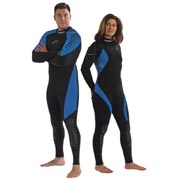 But swimming in 70 degree water quickly feels cold. That's because water removes heat from the human body about 20 times quicker than air. What happens is that the body heats up a thin layer of water surrounding it. That water then expands and moves up, to be replaced by cold water. That cycles continues until you feel cold. This happens even in what one might consider very warm water, say 80 degrees. Water would have to be in the 90s in order for a human being to feel comfortable in it over an extended period of time. The underlying reason is that our average body temperature is just under 100 degrees Fahrenheit. If the water is any cooler than that, heat loss occurs, and it happens the faster the greater the temperature differential between body and water temperature. The couple shown above, by the way, is wearing Oceanic Ultra wet suits.
But swimming in 70 degree water quickly feels cold. That's because water removes heat from the human body about 20 times quicker than air. What happens is that the body heats up a thin layer of water surrounding it. That water then expands and moves up, to be replaced by cold water. That cycles continues until you feel cold. This happens even in what one might consider very warm water, say 80 degrees. Water would have to be in the 90s in order for a human being to feel comfortable in it over an extended period of time. The underlying reason is that our average body temperature is just under 100 degrees Fahrenheit. If the water is any cooler than that, heat loss occurs, and it happens the faster the greater the temperature differential between body and water temperature. The couple shown above, by the way, is wearing Oceanic Ultra wet suits.
There are other reasons why divers wear exposure suits. They protect against cuts, stings, abrasion, infection and other nasty things that can happen to bare skin. I mean, people dress for the occasion on land, so why should it be different underwater? In fact, if anything, there are more reason to dress appropriately underwater because there are more things that can go wrong. Of course, on dry land, people dress not only to protect themselves, they also dress to impress. Fortunately, the various exposure suit makers are well aware of that and you can get some pretty colorful and snazzy underwater wear. Most stress both their unique technologies as well as "up to the minute looks" or "new color combinations [that] reflect your need to always be one step ahead of the crowd." Wouldn't want to be caught with last year's styles now, would we?
Different kinds of exposure suits
There are three conceptually different kinds of exposure suits: dive skins, wet suits, and dry suits. Each kind comes in several varieties, and each is designed for specific environments.
Dive Skins
Dive skins are the thinnest, lightest exposure suit and offer the least amount of protection. They are only about half a millimeter thick. Some consist of Lycra, a trademarked DuPont product that is sort of a nylon/spandex fabric, sometimes with cloth on one side. Others use very thin neoprene or Polartec, a high tech material made by the company of the same name. Dive skins are very elastic, form-fitting, and come in numerous colors and combinations of colors. Those blessed with a killer figure or physique love them (of course, what constitutes a "killer figure or physique" is entirely in the eye of the beholder).
Dive skins generally have a zipper upfront, stirrups to keep the pant part from riding up, and a loop that goes around the thumb so the sleeves stay in place. Dive suits provide protection from corals, blisters and sunburn when out of the water, and they also provide a bit of warmth. Not that much, though as the water penetrates the suit there is little thermal insulation. If you need a dive skin that keeps you warm (to a degree), pick one that has a fleece lining. Or go for the kind of warm-water suit that has a bit of thermoplastic insulation between two layers of spandex. Those have the additional advantage of being wind-proof, and thus warmer out of the water under wind exposure. And they can be worn under wetsuits for extra inssulation.
Dive skins are almost exclusively worn in tropical waters with friendly underwater environments. The exception is that they can also be worn under wetsuits. In fact, wearing a dive skin makes donning a thick wetsuit a whole lot easier.
Wet suits
Wet suits are the most common type of exposure suits. They are made from a closed-cell foam neoprene material. The term "closed-cell" refers to the fact that neoprene contains separate gas bubbles. The gas in the bubbles, as well as the rubber material itself, provide thermal insulation as well as protection. The wet suit does not absorb water, but the suit is also not sealed at the extremities to keep water out. In fact, it is designed to allow a thin layer of water between the suit and the skin. The water warms up without easily giving up its heat due to the neoprene suit and thus becomes an additional layer of insulation. Note that the air bubbles inside the wetsuit compress as water pressure increases, so the suit becomes thinner and provides less insulation at depth.
The neoprene material is relatively fragile and is therefore sandwiched between two layers of material, a nylon fabric outside and either a fleece-like plush material or some sort of more flexible material inside. The problem with plush linings is that they reduce the stretchability and flexibility of thick wetsuits. These days most companies promote the stretch factor of suits with "glide skin lining." Glide skin designs have their proponents whereas others prefer an also flexible knit lining.
The term "wet suit" is somewhat generic as wet suits come in many configurations, styles, and thicknesses.
When little protection is needed, a "shorty" may do. 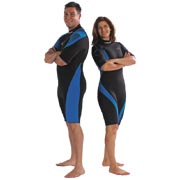 Shorty suits are one-piece suits with short sleeves and legs (though some have long legs). They provide some insulation and protection, but should generally be worn only in water 80 degrees Fahrenheit or higher. Shorties are usually made of thin neoprene, not more than 2-3 millimeters. And they, of course, leave arms and legs vulnerable to scratches or other minor injuries. The shorty wet suits shown to the left are from Oceanic's Ultra 2 Shorty line. As you can see, this suit has legs that end just above the knees and can easily be worn for other watersport activities. This particular model has a MSRP of U$99.95. Shorty suits are one-piece suits with short sleeves and legs (though some have long legs). They provide some insulation and protection, but should generally be worn only in water 80 degrees Fahrenheit or higher. Shorties are usually made of thin neoprene, not more than 2-3 millimeters. And they, of course, leave arms and legs vulnerable to scratches or other minor injuries. The shorty wet suits shown to the left are from Oceanic's Ultra 2 Shorty line. As you can see, this suit has legs that end just above the knees and can easily be worn for other watersport activities. This particular model has a MSRP of U$99.95.
Full body suits are one-piece affairs with a zipper in the front or back. They come in thicknesses of 3 to 7 millimeters, fit skin tight, and offer much more protection than a shorty or dive skin. However, even full body suits only provide enough insulation for water that's no colder than 70 degrees.
Below that, a third variation of the wet suit are 2-piece suits, also called "Farmer Johns" or jumpsuits. The "Farmer John" (or "Farmer Jane") moniker comes from one piece looking like an overall and the other like a jacket. That design provides a double layer of protection to the diver's midsection. 2-piece suits are usually made of thicker neoprene, generally up to 7 millimeters. 2-piece suits are easier to put on and take off. Add gloves and a hood, and a 2-piece suit can be worn in water temperatures down to about 50 degrees. We're not big fans of Farmer John/Jane suits as they are uncomfortable, cumbersome and extremely buoyant. They seem on their way out as more and more people use 7 mm jumpsuits with hooded vests and warm gloves instead, or wear a dry suit instead.
When selecting a wet suit, whatever style you pick, do make sure it fits well. There's nothing worse than an ill-fitting suit where the water sloshes around instead of generating the desired thin insulating film. And pick one that zips in the back. They are much easier to get out of than front zippers. Most importantly, schedule a good amount of time when shopping for a wet suit! They don't go on easy, and you might find yourself working up a good sweat by the second or third suit. Don't plan on making other important purchases (like a regulator, BC, or dive computer) during the same trip to your dive shop; the wet suit selection will take up most of your time.
Though we're not listing them as a separate category, there are "semidry" suits. They differentiate themselves from standard wet suits by having neoprene seals at the wrists and ankles to keep most, but not all, water out. The advantage of a semidry suit is that it retains the water better, which can make a difference for insulation purposes.
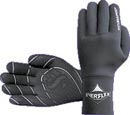 Wet suits can be worn with a number of accessories. Those include gloves
of various types and thicknesses, booties in many styles and designs, protective kneepads, special insulating vests worn underneath
the wet suit, hoods that can be separate or attached, spine pads to keep water from flowing where it shouldn't, pockets for special things, and even integrated or strap-on heat-packs that employ re-usable chemicals to provide half an hour's worth of heat or so. Wet suits can be worn with a number of accessories. Those include gloves
of various types and thicknesses, booties in many styles and designs, protective kneepads, special insulating vests worn underneath
the wet suit, hoods that can be separate or attached, spine pads to keep water from flowing where it shouldn't, pockets for special things, and even integrated or strap-on heat-packs that employ re-usable chemicals to provide half an hour's worth of heat or so.
Dry suits
A dry suit is what a diver wears in cold water, 50 degrees and below. As the name implies, a dry suit stays dry inside and allows no water in. It is made of high tech components and materials, essentially technology that emanated from the space program. Using a dry suit is significantly more complicated than a wet suit, and there are things that can go wrong. This is why there are special classes for dry suit diving and certification. And expect to pay quite a bit more for a dry suit than a wet suit.
Unlike wet suits that come in various configurations, all dry suits are full body suits. They are fully sealed, and there are special waterproof zippers. Obviously, in order for a dry suit to truly stay dry, every seal must be perfect. Seals are made of latex or neoprene, with large contact areas to provide the best possible seal. Each type of seal has its pros and cons. Latex seals are thinner and seal better, but they are somewhat fragile and some people are allergic to latex. Neoprene seals wear better, but are thicker and need to be stretched to fit. Seals are usually the first thing to break on a dry suit. They can be replaced, and some dry suits even have seals that can be zipped on.
You probably guess that the insulation provided by a dry suit comes from the air inside the dry suit. Unlike the water layer inside a wetsuit, the air inside a dry suit compresses and expands, which means the dry suit needs an air valve that allows for inflation from a low-pressure supply from the air tank. The valve is usually located on the chest. That way, the diver can add more air as s/he is going deeper. It also needs an exhaust valve, or "dump" valve. to purge expanding air during ascent.
Controlling the air inside a dry suit requires training and experience. You
wouldn't want for all the air to end up in your legs and you ascending feet
first.
Dry suits can be made of three different materials: Foam neoprene, membrane coated, and compressed and crushed foam.
Foam neoprene dry suits use the same kind of material as wet suits, which means they provide additional insulation, but their buoyancy varies with depth. Those suits are worn over light undergarments that trap air and provide a bit of extra insulation.
Compressed and crushed neoprene dry suits use special kinds of neoprene material that has been specially prepared to strengthen the material, bonding and stitching.
Membrane, or "shell," dry suits use a waterproof coating over the fabric. The coating is usually urethane or a laminate of rubber and some tough synthetic material. Such "shell" dry suits are lighter and more flexible than neoprene suits, but provide almost no insulation and have no positive buoyancy. The materials used do not stretch and are generally looser-fitting. All thermal insulation is provided by the air trapped inside the undergarments. Note that the looser fit makes it easier for air to move around and potentially get trapped where it shouldn't be.
Putting on a dry suit properly needs to be learned and all procedures must be observed in order for the suit to seal and function properly. Likewise, there are many rules on how to clean and store a dry suit properly. Follow those rules meticulously to keep the suit functional and protect your investment! Similar rules apply to the cleaning and storing of wet suits, of course.
What if you have to urinate when in a dry suit? That can be a problem. Some dry suits have zippers in the crotch area so you can go while on land, but that only works for males. Underwater, it's either incontinence pads or, for men, "pee-valves" that use condom-style catheters. That doesn't sound like a lot of fun and it isn't. Unfortunately, the bladder fills up quickly in colder temeratures, and so dry suit urinating is an issue that requires some planning as well as meticulous attention to hygiene.
Dry suits cost far more than wet suits, but they will outlast them by years! The life expectancy of a wet suit is about 400 dives, which means active divers can go through one or more per year. Properly maintained, dry suits will last for decades, with seals and the zipper the only parts that might need service. Many divers probably spend more on a succession of wet suits than they would on one really good dry suit.
What kind of suit should I get?
The answer is, "it depends."
It depends on the kind of diving you need the suit for, and where you'll be doing most of your diving. Serious and professional scuba divers generally have one or more of each, but beginners should figure out where they are most likely going to dive, and base their decision on that. The basic recommendation for new divers is to get a general purpose wet suit because it will work in a fairly large range of diving environments.
Once you settled on the type of suit, make sure you get something that fits properly. Bring along an experienced scuba diver or rely on the expertise of a dive shop employee or owner. Unless you really know what you're doing, an exposure suit is not something you should get from the Internet or a catalog.
Insulation guidelines
The below table (source: NAUI instructor Carol Cotton's course materials) shows the insulation requirements for different water temperatures, and what type of covering is most appropriate. Keep in mind that some people need more insulation and others less:
| TEMPERATURE |
TYPE OF COVERING |
| 85F and above |
Skin |
| 75-85F |
Thin wet suit |
| 55-75F |
5-7mm wet suit |
| 35-55F |
Dry suit |
| Below 35F |
Speciality dive |
|

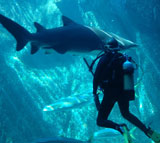

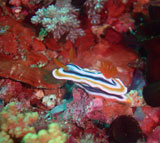
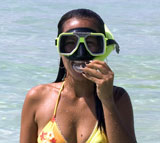
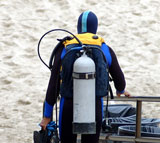

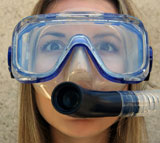



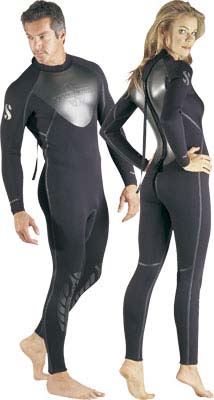 The wet suits to the left are from Scubapro's Barrier Steamer line that's geared towards demanding divers. The line uses Scubapro's Hydro Seal that consists of fluid rubber on the outside over stitching, is virtually indestructible and stops any water flow. In addition, stitching is protected from potential unraveling. Materials used include a Glideskin exterior on the external torso section. There's a superfine and smooth Heliospan weave that keeps vital body organs warmer. Arms and legs use fast drying and durable N2S neoprene. There is seal protection over all outside stitching. The suits have Scubapro's exclusive new Tatex kneepads that are abrasion-resistant and maximize freedom to move. Metal main zipper sliders provide extra durability and consistent, easy of operation. Wrist and ankle panels use EverFlex exterior and an inner seal of smooth skin that offers excellent water seal but is very easy to put on and take off, wet or dry. The raw cut collar neck line is comfortable, has interesting styling and great comfort compared to traditional roll cut collars. There is also a nylon webbing thumb loop at the base of all back zippers to get things on and off by yourself. Finally, there is a compression molded combination zipper flap/spine pad. The suits come in Small to XXXL for men and XS to XXL for women.
The wet suits to the left are from Scubapro's Barrier Steamer line that's geared towards demanding divers. The line uses Scubapro's Hydro Seal that consists of fluid rubber on the outside over stitching, is virtually indestructible and stops any water flow. In addition, stitching is protected from potential unraveling. Materials used include a Glideskin exterior on the external torso section. There's a superfine and smooth Heliospan weave that keeps vital body organs warmer. Arms and legs use fast drying and durable N2S neoprene. There is seal protection over all outside stitching. The suits have Scubapro's exclusive new Tatex kneepads that are abrasion-resistant and maximize freedom to move. Metal main zipper sliders provide extra durability and consistent, easy of operation. Wrist and ankle panels use EverFlex exterior and an inner seal of smooth skin that offers excellent water seal but is very easy to put on and take off, wet or dry. The raw cut collar neck line is comfortable, has interesting styling and great comfort compared to traditional roll cut collars. There is also a nylon webbing thumb loop at the base of all back zippers to get things on and off by yourself. Finally, there is a compression molded combination zipper flap/spine pad. The suits come in Small to XXXL for men and XS to XXL for women.
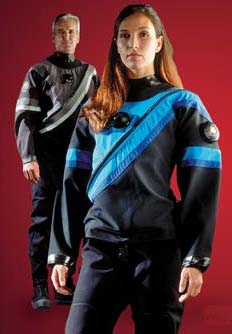 The divers shown in the picture on the right wear Diving Unlimited International's FLX50/50
dry suits made of DUI's patented CF200 material on the bottom and a trilaminate Polyester/Butyl rubber/Polyester composite on the top. The suit uses an also patented QuickZip design and has telescoping torso, crotch strap and suspenders. There's a zipper guard, a warm neck collar, a RockBoot system, an internal waist adjustment cord, and knee pads. The suit represents a compromise
between the company's more rugged models such as the CF200, and their lightweight and flexible TLS350 suit. Men's and women's models have different colors, and the suits come in four levels: Stock, Select, Special Production, and Signature Series. The latter two are made to order. Prices start at US$2,178 for Stock Sizes and go up to US$2,798 for the Signature Series.
The divers shown in the picture on the right wear Diving Unlimited International's FLX50/50
dry suits made of DUI's patented CF200 material on the bottom and a trilaminate Polyester/Butyl rubber/Polyester composite on the top. The suit uses an also patented QuickZip design and has telescoping torso, crotch strap and suspenders. There's a zipper guard, a warm neck collar, a RockBoot system, an internal waist adjustment cord, and knee pads. The suit represents a compromise
between the company's more rugged models such as the CF200, and their lightweight and flexible TLS350 suit. Men's and women's models have different colors, and the suits come in four levels: Stock, Select, Special Production, and Signature Series. The latter two are made to order. Prices start at US$2,178 for Stock Sizes and go up to US$2,798 for the Signature Series.